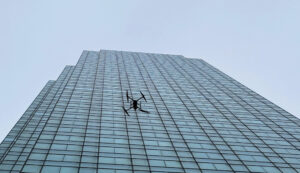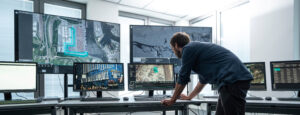How Drone Building Examinations Help QEWIs Work Smarter and Faster
 Qualified Exterior Wall Inspectors (QEWIs) play a critical role in keeping buildings safe—especially in New York City, where Local Law 11 requires detailed facade reports every five years for buildings taller than six stories. But in recent years, the pressure on QEWIs has grown.
Qualified Exterior Wall Inspectors (QEWIs) play a critical role in keeping buildings safe—especially in New York City, where Local Law 11 requires detailed facade reports every five years for buildings taller than six stories. But in recent years, the pressure on QEWIs has grown.
Fewer professionals now meet the updated qualifications, physical inspection requirements have increased, and project timelines remain tight. At AeroSpect, we support QEWIs with drone building examinations that reduce delays, improve accuracy, and help simplify the inspection process from start to finish.
The Growing Demands on QEWIs
In response to several serious facade accidents, New York City has raised the bar for facade safety. Under the current rules, only inspectors with at least seven years of relevant experience can file Local Law 11 reports. In addition, inspectors must now perform physical “drops” every 60 feet to assess building conditions hands-on. These changes add time, cost, and complexity to each job.
With fewer inspectors available and more detailed inspections required, many QEWIs face growing backlogs and tight reporting windows. Drone-based data offers a better way to manage that workload.
How Drone Building Examinations Streamline Facade Reporting
Using drones for building inspections, we can collect complete images of a building’s exterior in just a few hours. Our system captures every part of the facade—from top to bottom—with high-resolution clarity. The results include geo-located images, detailed orthomosaic maps, and a clean visual record that QEWIs can use to build accurate, thorough reports.
This level of visual detail helps inspectors see early signs of wear, damage, or structural issues that may need further review. It also gives them a stronger reference when documenting repairs or recommending future maintenance.
Why QEWIs Trust AeroSpect
Since 2018, we’ve worked on nearly 100 buildings throughout New York City—including major landmarks like the Empire State Building and New York Stock Exchange. Our team is FAA-licensed, fully insured, and legally authorized to operate drones in all five boroughs.
We’ve built long-standing relationships with some of the city’s leading engineers and architects. These clients rely on us not just for quality imaging and facade inspections, but for our ability to adapt to their workflows and deliver exactly what they need, when they need it.
Simplifying the Process with the AeroSpect Web Portal
One of the biggest advantages we offer is the AeroSpect Web Portal. This secure, cloud-based tool allows QEWIs and their teams to view, annotate, and download building imagery from any device. Instead of sorting through scattered files, inspectors can use the portal to organize data in one place and collaborate remotely with colleagues or clients.
We also offer offline delivery options, including hard drives, for firms that prefer to store data locally. And if you need integration with CAD platforms, we can match most formats and work with your templates directly.
Pinpointing Drop Locations with Accuracy
Physical drops are still a required part of any Local Law 11 inspection. But with drone building examinations, QEWIs can be more precise about where to perform them. Our image maps give inspectors a complete view of the facade before setting up any scaffolding or equipment.
This helps reduce unnecessary drops and allows inspectors to focus only on areas that show signs of concern. As a result, property owners avoid extra costs and delays, and inspectors avoid redundant site work.
Adding Value with Thermal Imaging
 Sometimes, problems aren’t visible to the naked eye. That’s why we also offer aerial thermography. This technique detects heat differences across building surfaces, helping inspectors spot moisture, poor insulation, or leaks related to HVAC systems.
Sometimes, problems aren’t visible to the naked eye. That’s why we also offer aerial thermography. This technique detects heat differences across building surfaces, helping inspectors spot moisture, poor insulation, or leaks related to HVAC systems.
Our team includes a Level II Certified Thermographer, trained by the Infrared Training Center (ITC). The thermal images we provide are clear, detailed, and formatted for use in inspection reports or insurance filings.
Spend More Time Analyzing, Less Time Gathering
QEWIs are responsible for interpreting building conditions, not collecting raw data. Drone examinations shift the focus back to that core work. By minimizing the time spent on site and maximizing the detail available in post-processing, we help inspectors complete their reports faster—without sacrificing quality.
The time saved can be used to evaluate trends across past inspections, cross-check problem areas, or consult with clients about maintenance options. It also allows QEWIs to take on more projects with less burnout.
Ready to Level Up Your Process? Work with AeroSpect.
Drone building examinations give QEWIs a practical way to keep up with rising inspection standards and heavy workloads. At AeroSpect, we’ve built our service to meet your exact needs—whether you’re working with CAD models, needing help with drop planning, or looking to speed up your turnaround times.
To learn more, request a consultation or demo by contacting us online, emailing us at info@aerospectny.com, or calling 718-551-3363. We’re here to support your next project with accurate, efficient, and reliable drone-based inspection data.
